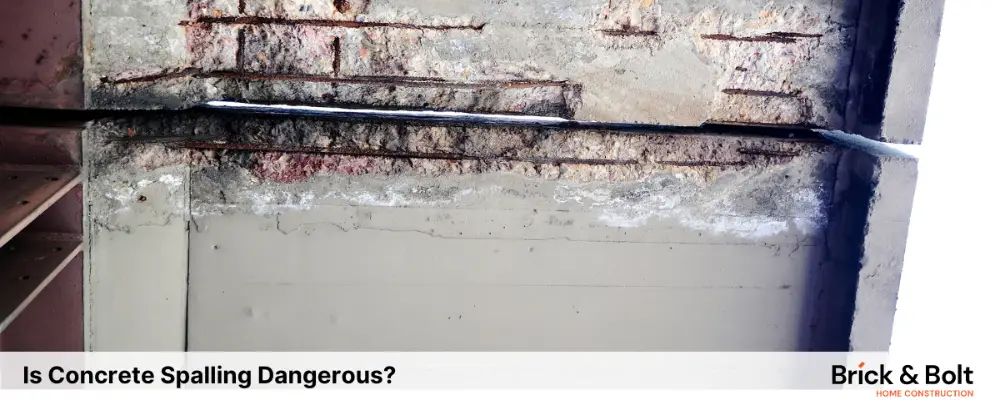Spalling refers to the breaking off of pieces of concrete from a surface. Just think of walking on a sidewalk and noticing that sections have chipped away or crumbled. Visually, that is what concrete spalling might look like, and that could also happen to buildings, bridges, and other structures. But is it dangerous? Let’s find out.
What is Spalling in Concrete?
Concrete is a dense combination of cement, water, and other added ingredients, like sand or gravel. Over time, it may degrade due to improper care of the concrete. This is what they call spalling-when the breaking up of concrete is already obvious. First, tiny cracks or flakes may appear on the surface, and if this condition gets worse, it may result in the chipping off of substantial parts of concrete.
What are the causes of concrete spalling?
Some things might let concrete to spall:
- Water: If water seeps into the concrete, it can rust the steel bars inside it. The expansion of these bars due to rust is responsible for causing the concrete to push outwards and thus results in the breaking of the concrete.
- Cold Weather: In those places where the temperature falls considerably, water inside the concrete freezes and then thaws as it warms up. That kind of freezing and thawing causes cracking and spalling of concrete.
- Poor Construction: Sometimes, concrete is mixed or poured inadequately. A mix applied with too much water or fails to dry out completely will eventually weaken and, after some time, spall.
- Chemicals: Direct attack by strong chemicals, such as from ice-curing salts used on highways, can cause the concrete to deteriorate and spall.
- Too Much Weight: When too much weight is applied to concrete that was not supposed to bear weight, it cracks and spalls.
Recognising the Signs of Concrete Spalling
- Flaking or Chipping: Visible signs of flaking or chipping on the surface of the concrete. Spalled areas often have a rough, uneven texture.
- Exposed Aggregate: When spalling occurs, it can expose the aggregate within the mix of concrete, therefore leaving a pitted look on the surface.
- Cracks and Gaps in Concrete: The surface of the concrete should be checked for cracks and gaps within. Spalling is usually accompanied by the formation of cracks, which could deteriorate further or cause other hazards.
- Discolouration: Spalled areas can become discoloured, showing concrete that has weakened or been damaged.
Why is Concrete Spalling Hazardous?
Concrete spalling may not sound serious, per se, but workability can become hazardous for several reasons:
- Weakening Structures: When spalling occurs in concrete, it tends to weaken the structure from which it is a part. What that means is the building, the bridge, or the structure must not be as strong, and that could be dangerous.
- Falling Pieces: If large fragments fall off, they may hurt people or even damage anything that may be below them.
- More Water Infiltration: Cracks and openings due to spalling can let more water in, exacerbating the problem and causing further damage.
- Costly Repairs: The repairs that involve repairing spalled concrete are expensive, especially if the damage is extensive. Sometimes the costs accumulate when this is left unaddressed early in the process.
- Unsightly Appearance: While less dangerous, spalling affects buildings and sidewalks by giving them the look of age and deterioration, which could be a worry to property or building owners.
How to Prevent Spalling of Concrete
There are ways to stop spalling of concrete or at least retard its pace:
- Good Construction: Putting concretes properly mixed and correctly poured in the first place is the original step. The application of an appropriate quantity of water combined with the proper drying time can avoid spalling.
- Regular Checks: Inspecting concrete surfaces regularly can help catch spalling early before it gets worse.
- Keep Water Out: Sealers can prevent water from getting in and damaging the concrete with resultant spalling.
- Utilise Superior Materials: Using materials that do not corrode or rust as easily can help maintain the strength of the concrete.
- Allow for Movement: Putting in special joints at large areas of concrete allows the concrete to expand and contract without cracking.
How to Repair Concrete Spalling
It is important to then fix spalling that has already started to avoid bigger problems:
- Patching: Small spalled areas can simply be patched up with new concrete. This is often limited to cleaning the area and refilling the same area with fresh material.
- New Layer Addition: In the case of heavy-area spalling, the laying of a new concrete layer can be done over the damaged portion.
- Epoxy Injection: If the spalling has caused cracks, epoxy can be injected to fill gaps and hold concrete together.
- Treatment of Steel Bars: Potentially, spalling occurred because the steel bars rusted. In this respect, they may require either treatment or replacement to stop the damage.
- Replacing Concrete: If the damage is too severe, the old concrete might need to be removed and replaced with new concrete.
Conclusion
Concrete spalling refers to the breaking of concrete apart, which becomes dangerous if not corrected. It may weaken buildings and other structures, cause pieces of concrete to fall, and can be so expensive to repair. On the other hand, good care in maintenance and repairs on time can reduce such damage to the concrete and keep structures safe and durable.
FAQs
Spalling is a condition wherein the concrete breaks and causing flakes or cracks on the surface.
Causes include water getting inside the concrete, cold weather, poor construction, chemical exposure, and too much weight.
Yes, it can weaken the structures and cause falling debris, which would be very costly to repair.
Good construction practices, regular inspection, keeping water out, using improved materials, and providing for movement.
Small areas can be patched, large areas, a new layer can be added, cracks can be filled with epoxy, and severely damaged concrete needs to be replaced.

